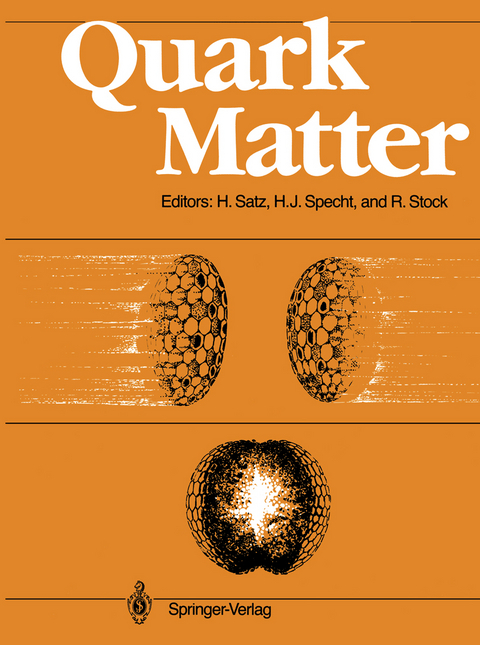
Quark Matter
Springer Berlin (Verlag)
978-3-642-83526-1 (ISBN)
Helmut Satz, geb. 1936, war von 1971 bis 2001 Professor für Theoretische Physik an der Universität Bielefeld. Sein Forschungsschwerpunkt ist die Physik der ersten Sekundenbruchteile nach dem Urknall. Zusammen mit seinem Schüler Frithjof Karsch machte er Bielefeld zu einem der weltweit führenden Zentren für die Untersuchung von Materie bei extrem hohen Dichten und Temperaturen.
Professor Reinhard Stock has worked for many years at the Nuclear Research Centre CERN in Geneva, where he e.g. performed research on the early universe plasma state. In 1989 he was awarded the Leibniz Prize. Until now he was professor at the renowned High Energy and Particle Physics Department of the Goethe University of Frankfurt.
Oxygen-induced reactions at 60 A GeV and 200 A GeV studied by calorimetry (With 6 Figures).- Transverse energy distributions in 16O-nucleus collisions (With 2 Figures).- Study of the energy flow in 16O-nucleus collisions at 60 and 200 GeV/nucleon (With 14 Figures).- Measurement of energy and charged particle emission in the central rapidity region from O+A and p + A collisions at 14.5 GeV/c per nucleon and preliminary results from Si+A collisions (With 12 Figures).- Transverse energy distributions in Si-nucleus collisions at 10 GeV/nucleon (With 7 Figures).- Charged particle spectra in 16O induced nuclear collisions at the CERN SPS (With 8 Figures).- Measurement of multiplicity distributions in oxygentungsten collisions at 200 GeV per nucleon (With 6 Figures).- Review of high energy heavy ion reactions in emulsion (With 13 Figures).- First results from the hybrid emulsion experiment on 16O-nucleus collisions at 200 GeV/N (With 7 Figures).- Pion interferometry with ultrarelativistic heavy-ion collisions from the NA 35 experiment (With 5 Figures).- Spectra of negative particles and photons in collisions of p-W and 16O-W at 200 Ge V/u (With 3 Figures).- Negative particle production in nuclear collisions at 60 and 200 GeV/nucleon (With 11 Figures).- Neutral transverse momentum spectra in 60 and 200 A GeV16O + nucleus and proton + nucleus reactions (With 8 Figures).- Transverse momentum systematics in proton-proton and light ion collisions at the ISR (With 7 Figures).- Target fragmentation in proton-nucleus and 16O-nucleus reactions at 60 and 200 GeV/nucleon (With 12 Figures).- The production of J/? in 200 GeV/A oxygen-uranium interactions (With 11 Figures).- First results on strangeness production in 60 and 200 GeV/nucleon heavy ion reactions from the NA 35 streamerchamber (With 5 Figures).- A study of ? and K production in proton-uranium and oxygen-uranium interactions at 200 GeV/A using decay muons (With 18 Figures).- Preliminary spectrometer results from E-802 (With 5 Figures).- The QCD vacuum and quark-gluon plasma (With 5 Figures).- Lattice QCD at finite temperature: a status report (With 10 Figures).- Connection between perturbation theory and lattice QCD (With 3 Figures).- On a non-perturbative pressure effect in lattice QCD (With 2 Figures).- The "instanton liquid" (With 8 Figures).- Quarks and gluons in colour fields (With 6 Figures).- A unified approach for hadronic and nuclear collisions: the dual parton model (With 16 Figures).- The materialization phase in the colour rope picture (With 4 Figures).- Ultra-relativistic heavy ion collisions in a multi-string model (With 6 Figures).- Multiplicity distributions in hadronic and heavy ion reactions.- The approach to equilibrium in a quark-gluon plasma.- Gluon transport equations, plasma oscillations, and screening.- Central region in relativistic heavy ion collisions; results from hydrodynamic calculations and cascade simulation (With 12 Figures).- Initial state formation in the hydrodynamical theory of nucleon-nucleon collisions.- Rapidity distributions and energy densities from hydrodynamical studies at 5-200 GeV/n (With 14 Figures).- J/? Suppression by plasma formation (With 1 Figure).- Mass shifts of charmoniums and electromagnetic signals (With 3 Figures).- Searching photon signal of quark-gluon plasma formation.- Quark-matter diagnostics: dileptons, photons and (J/?) suppression (With 6 Figures).- Perturbative aspects of dilepton production at finite temperature (With 1 Figure).- Strong interacting probes for quark gluon plasma (With 3 Figures).- ?(??)Longitudinal polarization: a signature for the formation of a quark-gluon plasma in heavy ion collisions.- Enhanced multiplicity fluctuation as a possible signature of quark matter.- Emission of droplets of strange quark matter in RHIC (With 10 Figures).- Dense nuclear matter: supernovae and heavy ions (With 10 Figures).- Quark matter in astrophysics and cosmology (With 3 Figures).- Hadron-quark phase transition in dense stars (With 4 Figures).- The EMC effect - status and perspectives (With 6 Figures).- The ion programme at CERN: a brief outline.- Lead beam experiments at the CERN SPS (With 10 Figures).- The time projection chamber for heavy-ion collisions: trends and perspectives (With 22 Figures).- The relativistic heavy ion collider project: a status report (With 6 Figures).- Quark Matter 1987: concluding remarks.
| Erscheint lt. Verlag | 1.3.2012 |
|---|---|
| Zusatzinfo | VI, 370 p. 17 illus. |
| Verlagsort | Berlin |
| Sprache | englisch |
| Maße | 210 x 280 mm |
| Gewicht | 926 g |
| Themenwelt | Naturwissenschaften ► Physik / Astronomie ► Atom- / Kern- / Molekularphysik |
| Naturwissenschaften ► Physik / Astronomie ► Hochenergiephysik / Teilchenphysik | |
| Naturwissenschaften ► Physik / Astronomie ► Quantenphysik | |
| Naturwissenschaften ► Physik / Astronomie ► Theoretische Physik | |
| Schlagworte | CERN • Collision • Hadron • Quantum Chromodynamics • Quark • Radiation |
| ISBN-10 | 3-642-83526-0 / 3642835260 |
| ISBN-13 | 978-3-642-83526-1 / 9783642835261 |
| Zustand | Neuware |
| Haben Sie eine Frage zum Produkt? |
aus dem Bereich


